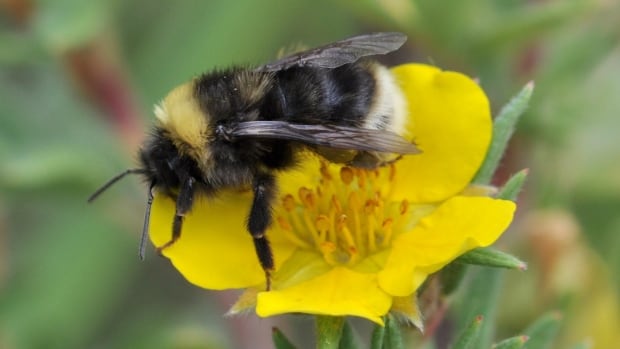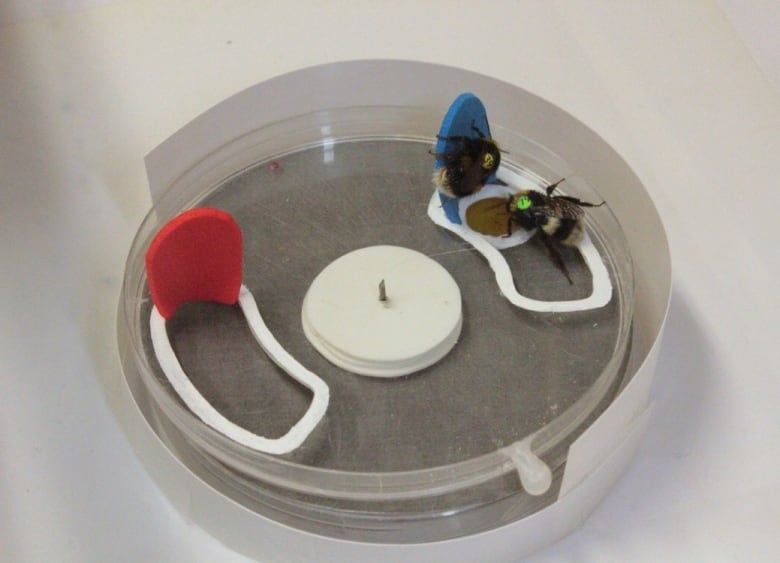
As It Happens5:58Scientists taught individual bees to solve puzzles. Soon, whole colonies knew how
Bumblebees are social learners who follow cultural trends, a new study suggests.
New research out of the U.K. shows that if you teach a bumblebee how to solve a puzzle in order to get a tasty treat, other bees in the colony will quickly learn that same skill through observation.
And when bees are shown multiple solutions to the same puzzle, a colony will — over time — develop a preference for one technique over another.
“The reason this was so, so amazing really was that it seems as though the bumblebees were capable of a form of culture,” lead author Alice Bridges told As It Happens host Nil Köksal.
By culture, she means bees learn specific behaviours from each other, and different colonies adopt different sets of behaviours. This is not unlike how people from different backgrounds have culturally specific ways of, for example, preparing a certain dish.
“Not many people have really thought about culture in invertebrates, and certainly not in insects like bumblebees, who have basically brains the size of a pinhead,” said Bridges, a biologist at Anglia Ruskin University in Cambridge, England.
The findings, which focused on the buff-tailed bumblebee (Bombus terrestris), were published in the journal PLOS Biology.
Flowers are puzzles, too
According to the study, it was long believed that the “astonishing behavioural repertoires of social insects” are innate.
But in recent years, scientists have begun to understand that bumblebees have an incredible capacity for both individual and social learning.
In an effort to better understand how bees acquire skills from one another, Bridges developed a puzzle box made from a petri dish containing a drop of sugar solution for the bees to slurp up.
There are two ways to open the dish and get at the sugar: The bees can either rotate the lid clockwise by pushing a red tab, or they can rotate it counter-clockwise by pushing a blue tab.

Bridges and her colleagues trained some of the bees individually on each method. Then they introduced these “demonstrator bees” into larger colonies, and gave those groups access to the petri puzzles.
In the colonies where the demonstrator bee had learned to push the red tab, that technique quickly spread to the whole group. A similar phenomenon occurred in the blue group.
“Each colony, depending on which demonstrator we’d added, was actually learning different behaviour, sort of like a local fashion trend,” Bridges said.

Behavioural ecologist Ralph Cartar, who was not involved in the study, says the findings mimic how bees behave in nature — especially when they’re trying to get nectar from a particularly complex flower.
“The bee is essentially doing this puzzle solving — you know, it’s landing on a flower that’s closed and pushing it open and then sticking its tongue in to get the reward,” said Cartar, a University of Calgary professor emeritus who has studied bees for decades.
And they figure this out by — you guessed it — observing each other.
In fact, he said, bees learn a lot by watching each other, like which flowers are a good source of nectar, and which ones contain deadly predators.
“All these things show that bees in the wild pay close attention to what … the others are doing. They’re not just acting in a vacuum,” he said.
There were, however, some elements of the study that took Cartar by surprise.
In a control experiment with no demonstrator bees, some of the bees solved the puzzles on their own — but they only did it once or twice, and the behaviour didn’t spread to the rest of the colony.
“Why the heck did that happen?” Carter said. “It’s a puzzling thing.”
What’s more, when the researchers introduced both blue and red demonstrator bees to the same colony, the bees still developed an overwhelming preference for one method over the other.
That’s odd, says Cartar, because while individual bumblebees will have preferred food sources, the species as a whole are generalists, meaning they experiment with lots of different kinds of flowers.
In the wild, that’s because they’re looking for the best bang for their buck — whereas in the experiment, blue and red yielded the same results. So It’s possible that given equal rewards, the bees just stuck to what they were used to.
But that’s just a theory, he said, and more research is needed to say for sure.
“It’s beautiful to see a study that gives you a puzzle,” Cartar said.
Bumblebee ‘civilizations’
Co-author Lars Chittka, a behavioural ecologist at Queen Mary University of London, says the findings demonstrate that bees are “far smarter creatures than a lot of people give them credit for.”
“We tend to overlook the ‘alien civilizations’ formed by bees, ants and wasps on our planet, because they are small-bodied and their societies and architectural constructions seem governed by instinct at first glance,” Chittka said in a university press release.
In fact, Cartar says people have a long history of underestimating other species’ abilities.
“I think that’s partly because we think so much of ourselves, and so little of other things, that we’re always surprised what others can do,” he said.
“But, you know, when you think about it, we’re all set up to do well in the environments in which we evolved. And bees do bee things very well.”